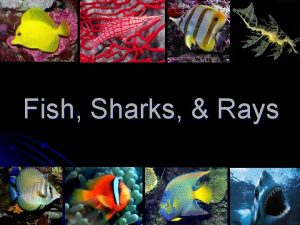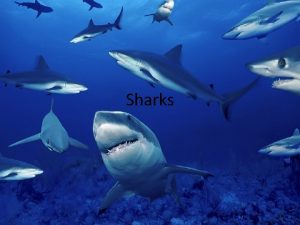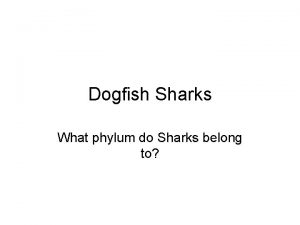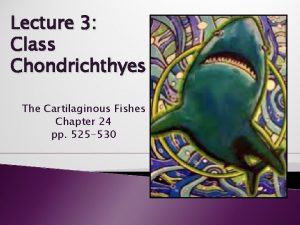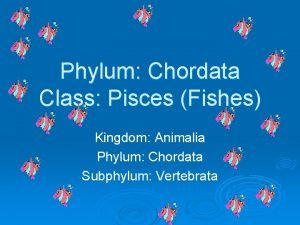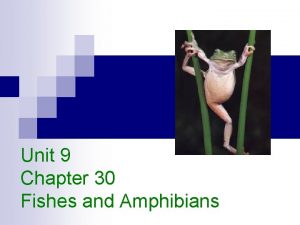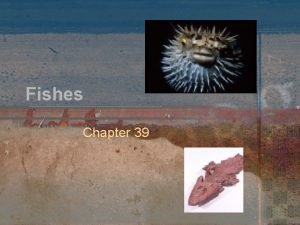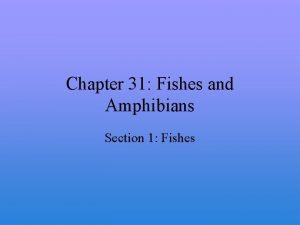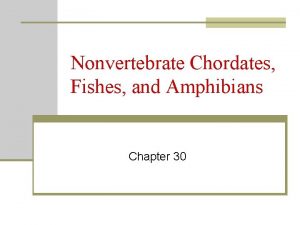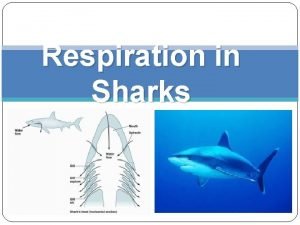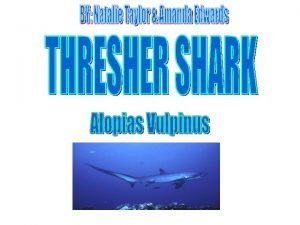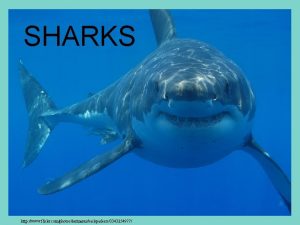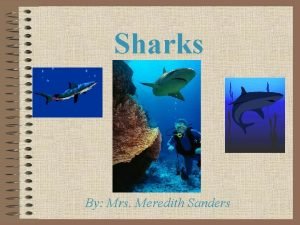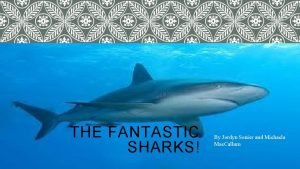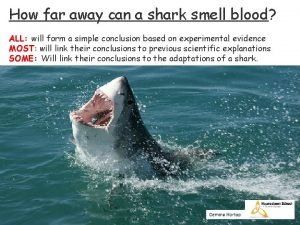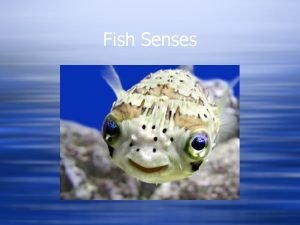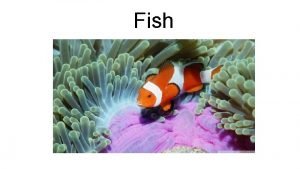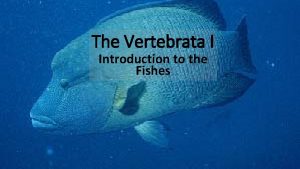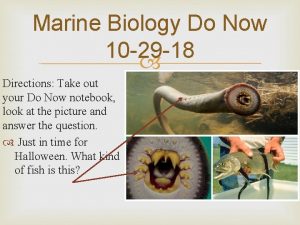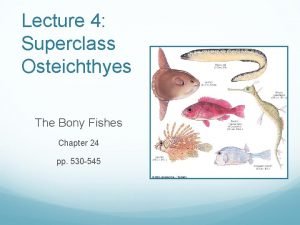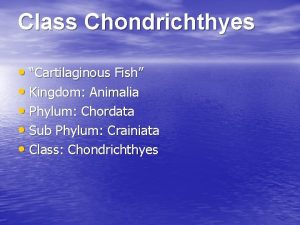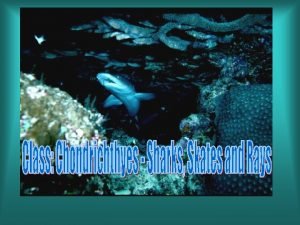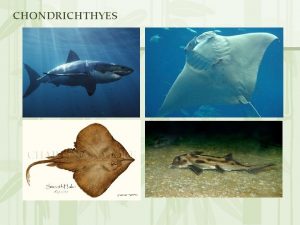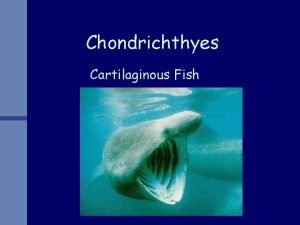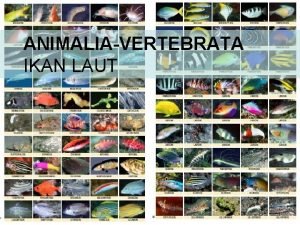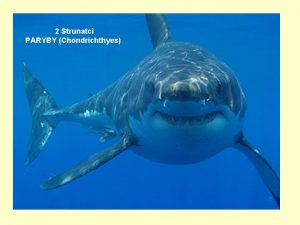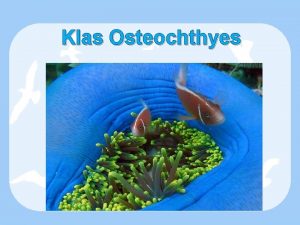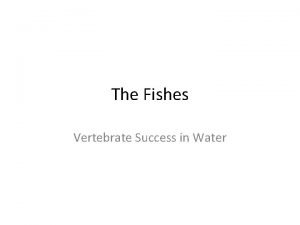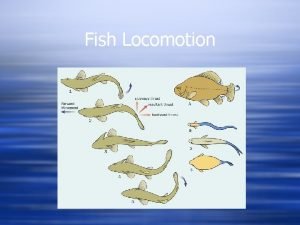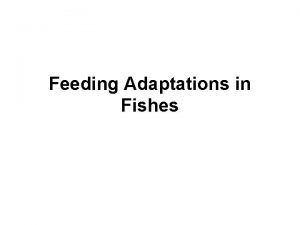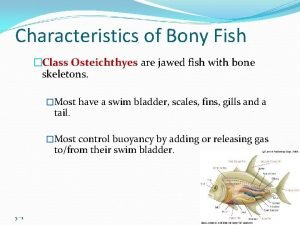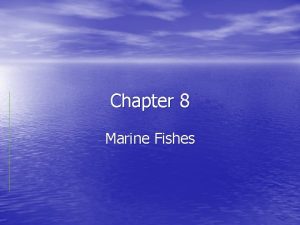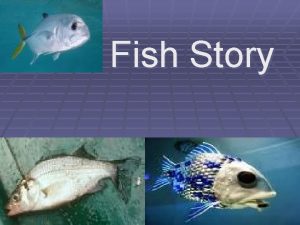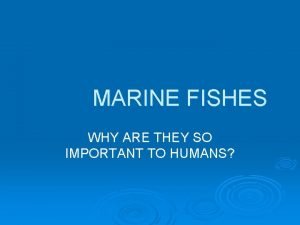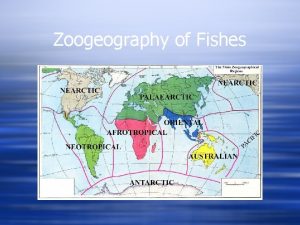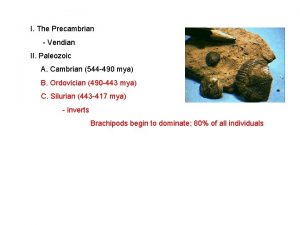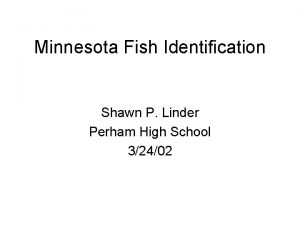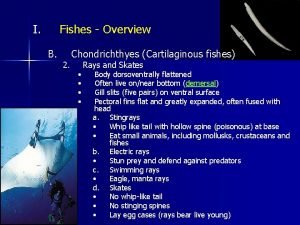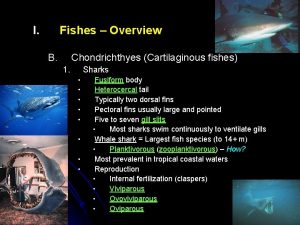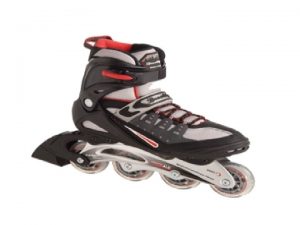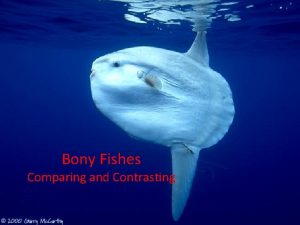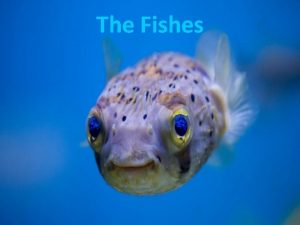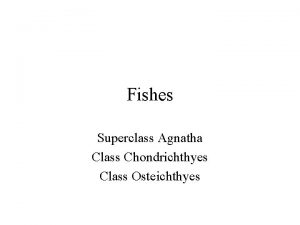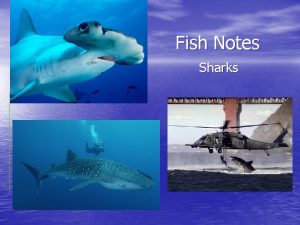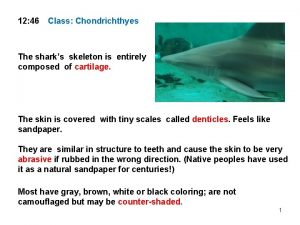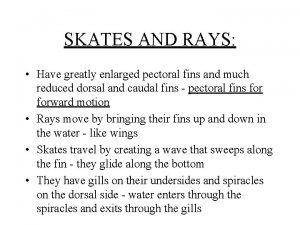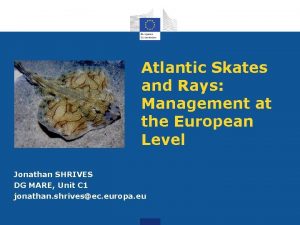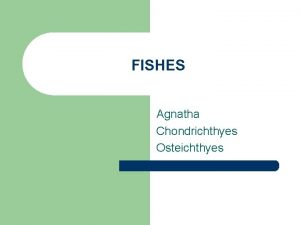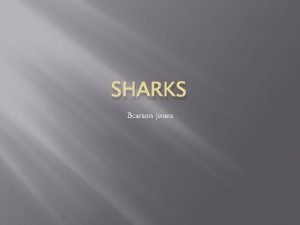Class Chondrichthyes cartilagenous fishes rays skates sharks and



















































































- Slides: 83


Class Chondrichthyes • • • cartilagenous fishes : rays, skates, sharks, and ratfishes Distinguishing Characteristics cartilage skeleton w/Ca 2+ granules Placoid scales also known as Denticles Big Phylum advance – paired fins movable jaws well developed teeth

Advances PAIRED FINS Moveable Jaws Well Developed Teeth

External Covering All have placoid scales Rays – few rows on back; sometimes modified into spines Sharks – skin overlapping into lightweight, protective coat fast-swimming sharks have channels between scales to minimize turbulence

Placoid scales of sharks • These fishes have teeth-like scales called denticles. • They are similar in structure to teeth and cause the skin to be very abrasive if rubbed in the wrong direction.

Class: Chondrichthyes - Sharks and Rays The shark’s skeleton is entirely composed of cartilage. Most have gray, brown, white or black coloring; are not camouflaged but may be counter-shaded. Also have ventral mouth (underneath) Only predators are toothed whales and man. Puffer fish can accidentally suffocate a shark by blocking water from entering the gills resulting in death for both.

Countershading Ventral Side is lighter to blend in with the sea surface when below the shark Dorsal Side is darker to blend into the substrate when above the Shark

Shark’s tooth like scales are called 1. 2. 3. 4. Scales Denticles Toothskin Armoricles

Darker Dorsal coloring and lighter ventral coloring is known as 1. 2. 3. 4. Camouflage Two tone shading Counter Shading Bioluminescence

Shark cartilage has not been proven to prevent cancer, and sharks with tumors have been observed. Circulation: 2 chambered heart; cold-blooded Respiration: Gills are located in muscular slits behind the mouth. They exchange oxygen from the water into the blood. Sharks lack swim bladders and must constantly swim upwards to balance their weight. They do sleep.

Respiration 3 basic means of respiration 1) Two-pump system (like teleosts) – pump O 2 water across gills in slow-moving, bottom oriented sharks 2) Ram ventilation – push water across gills during swimming; fast-moving sharks 3) Spiracles – used to bring water across gills; small round opening precede gills on lateral sides of head – on top of head in rays – almost absent in pelagic sharks

Spiracle allows the shark to take in water even when their ventral mouth is buried in the sand

Senses: Vision is good in clear water. Eyelids close from the bottom upwards to prevent injury during an attack. Nictitating Membrane protects the eye when the shark attacks its prey Smell is excellent. Olfactory lobes compose 2/3 of the brain. Sharks can detect a drop of blood 1/4 mile away in the water and can determine the direction of the source. Hearing is excellent. Sound vibrations can be detected by the lateral line from 3, 000 feet away. Esp low frequency hearing The electrical impulses of breathing from a prey can be picked up through pores in the face in structures called Ampullae of Lorenzini.

Sharks have a _____ chambered heart 1. 2. 3. 4. 1 2 3 4

Two thirds of the shark brain is devoted to the sense of 1. 2. 3. 4. Sight Motion Smell Hearing

The whale shark is over 50 feet long. It is a filterfeeder with baleen instead of teeth. Largest shark Great White sharks are found in the temperate and tropical oceans worldwide.

Which two Sharks are filter feeders 1. Whale Shark and Basking Shark 2. Tiger Shark and Bull Shark 3. Lemon Shark and Whale Shark 4. Basking Shark and Nurse Shark

Vertebrate jaws evolved from skeletal supports of the pharyngeal slits

Sharks have a ____ mouth 1. 2. 3. 4. Dorsal Lateral Ventral Anterior

Predation: Efficient, top carnivore of the sick, weak, old and injured. Sharks will not eat Moses sole. Jaw is lined with rows of teeth like a conveyor belt. Teeth can be replaced every 24 hours and are used to identify species. Jaw can be extended out of the mouth for extra reach. There are over 370 species of Sharks known to man. Mote Marine Laboratory in Sarasota, FL is a leading research center in shark immunology.

Replaceable teeth

Sharks have amphistylic suspension of jaw Upper jaw not fused to chondrocranium – only by a couple of ligaments Whips upper jaw down into prey. Drives Jaw deeper into the victim.


Teeth can be replaced every ______ hours 1. 2. 3. 4. 12 48 24 6

Be able to identify the fin and Clasper Locations !!!!

Shark Parts • • Pectoral fins – provide lift Dorsal, anal, pelvic fins – rudders/skegs Heterocercal caudal fin – lift, propulsion Claspers – modified part of pelvic fin on males for mating

Fixed Pectoral Fins

Reproduction • Reproduction is internal • Cartilaginous fish are either • Ovoviparous – meaning the female retains the eggs within her body. The embryo gets nutrition from yolk of egg. OR Vivapous- live bearers. Embryo gets the nutrition directly from the mother.

Reproduction Osmoregulatory and reproductive systems likely evolved simultaneously; Long gestation periods of embryos (in egg or ♀, would not be possible without ability to withstand high concentrations of waste

Reproduction Unlike most bony fishes (teleosts) put most energy into relatively small number of large, active, young (ecological term? ) Wide variety of means to this end: egg laying (oviparity) to live bearing (viviparity); all stages inbetween

Horn Shark

Horn Shark Egg Case

Claspers modified fin for reproduction

Reproduction: sexual, internal fertilization. Most sharks have live births - dogfish have 4 -10 pups, tiger sharks may have 80 -100 at one time. A few species lay eggs.

Shark Structures Reflect Predatory Lifestyle • Teeth – on replaceable “roll” • Nares – for smelling + huge olfactory bulbs • Ampullae of Lorenzini – sense electrical fields • Lateral Line system – senses water vibrations (bony fish also have) • Good vision (but not color) • Reasonable hearing – esp low freq.

Ampullae of Lorenzini

Ampullae of Lorenzini

Nictitating Membrane & Ampullae of Lorenzini

Lateral Line (shown on bony fish, but sharks also have it) Used to sense movement

Lateral Line

Some Sharks are Plankton Eaters • Whale shark (largest fish) • Basking shark (sea monster stories) • Megamouth shark

Basking Shark Gill Rakers

Whale Shark

Megamouth Shark

Megamouth Shark

Basking Shark

Odd Shark Body adaptations Thresher Shark elongated caudal fin “Hammer” for lift, separates eyes and nares, may bash prey

Goblin Shark Deep water shark found off of the coast of Japan. Can grow to up to 14 ft long. Little is known of this Shark.

Buoyancy -no swimbladder -combination of methods to reduce density Cartilage less dense than bone (1. 1 vs 2. 0) Large, oil-filled liver (0. 8) (water 1. 0) Hydrodynamic lift from heterocercal tail & pectoral fins

External Covering Slow-moving sharks more “armored” - dorsal spines Rays – barb/sting Skates – denticles Teeth are modified placoid scales

Feeding Most are specialized predators – teeth dictate type of feeding Triangular, blade-like teeth – large fish & marine mammals Long, thin, pointed – whole fish Rows of small, sharp teeth – small inverts Flattened, pavement-like teeth – hardshelled inverts Pointed in front/flattened in back – small inverts (grasping and crushing)

Shark Feeding Teeth continually shed & replaced; may loose 30, 000 in lifetime Jaws loosely attached to cranium - can throw jaws or create suction Large stomach & spiral valve intestine

Movement Large heterocercal tail Counter-current heat exchangers in pelagic sharks (Lamnidae) Pectoral fins (Mylobatidae) – fly through the water

Movement Homocercal Heterocercal

Sensory Systems Odor – olfaction detects dissolved chemicals in the water Low frequency sounds – inner ear and lateral line system; “hear” and “feel” sound waves respectively Ampullae of Lorenzini – pit organs filled with an electrically conductive gel used for detecting weak electrical currents & magnetic fields

Osmoregulation Osmoregulators – regulate internal salt concentration approximately 1/3 seawater Utilize large quantities or organic salts (urea & trimethylene oxide) Invade marine, estuarine (brackish) and freshwater systems

Copyright © The Mc. Graw-Hill Companies, Inc. Permission required for reproduction or display CHORDATA Subphylum Vertebrata • White-tip reef shark (Triaenodon obesus), Fiji • Indo-Pacific and east Pacific, common on reefs resting under plate corals Photo Copyright © Diane R. Nelson

Copyright © The Mc. Graw-Hill Companies, Inc. Permission required for reproduction or display CHORDATA Subphylum Vertebrata • Gray reef shark (Carcharhinus amblyrhynchos), Blue Corner, Palau • Numerous on reefs in Indo-Pacific • Often in groups to hunt fishes Photo Copyright © Diane R. Nelson

Shark attacks on humans are rare, but with more people in the water the odds are increased. Sharks may be looking for new food sources due to over fishing. Most attacks occur in less than 6 feet of water, at dawn or dusk, during summer months. Risks are also increased for surfers and swimmers in water with reduced visibility. A surfer in black wet-suit, paddling out on a board, may look enough like a seal to interest a shark.

Most attacks occur in Florida, California, Australia, and Africa. Florida has 4 times the number reported in California. Most attacks are not fatal. Sharks only kill about 10 people worldwide per year. Bees kill hundreds of people and crocodile/alligator - related deaths number nearly 1000. People have done far greater damage to the shark population.

Shark Attack

Shark Attack

Most Shark attacks occurs during 1. 2. 3. 4. The Night Noon Dusk and Dawn The Evening

The two states where shark attacks occur most frequently are 1. Hawaii and California 2. Florida and Australia 3. Africa and Florida 4. California and Florida

Sharks kill about ______ people per year 1. 2. 3. 4. 1000 10 0

S-U-C-C-E-S-S Success due to adaptive characteristics: 1) buoyancy 2) respiration 3) external covering 4) feeding 5) movement 6) sensory systems 7) osmoregulation 8) reproduction


Rays and Skates • Same subclass as sharks • Most are Demersal – hover along the sea floor • Distinguishing characteristics • flattened bodies, pectoral fins modified to “flap” • gill slits and mouth on ventral surface, eyes are dorsal

Rays • Distinguishing Characteristics • Viviparous – Live births • Flat, platelike teeth –used to crush crustaceans • Streamlined tails, maybe barbs or spines

Order Mylobatiformes Family Platyrhinidae – (thornback ray) Family Zanobatidae – (pan rays) Family Hexatrygonidae – (longsnout stingray) Family Urolophidae – (round rays) Family Urotrygonidae – (smalleyed round ray) Family Dasyatidae – (stingrays) Family Potamotrygonidae – (river rays) Family Gymnuridae – (butterfly rays) Family Myliobatidae – (eagle rays) Spotted eagle ray Aetobatus nari Pelagic stingray Pteroplatytrygon violacea

Largest ray Manta Rays may have a 25 foot wide wing span. Video: Manta Rays in the Maldives Sting Rays have a venomous stinger in their tail. Shuffle your feet when wading to avoid stepping on it. Stingrays are generally docile and will swim close to divers and snorkelers without fear

Stingray injury • Injuries usually come from an unsuspecting person stepping on a stingray • Reflexive action by the stingray • Usually lower legs • Painful due to Protein based toxin in barb

Long spiny tail Dorsal eyes Flattened body Perfect for demersal living Modified pectoral fins used for flapping

The population in the Gulf of Mexico migrates, in schools of as many as 10, 000, clockwise from western Florida to the Yucatan. . Golden Rays also known as Cow nose rays

Manta Rays (plankton eaters)

Copyright © The Mc. Graw-Hill Companies, Inc. Permission required for reproduction or display CHORDATA Subphylum Vertebrata • Southern stingray (Dasystis americana), Bahamas • Venomous spine at base of whip-like tail • Often lie on bottom in sandy areas Photo Copyright © Diane R. Nelson

Skates • Distinguishing Characteristics • Oviparous (lay egg cases) • Cusped teeth – Carnivorous mainly benthic organisms • Fleshy tail w/ small fins Barndoor skate Great Camouflage!

Skate Egg Case Sometimes known as “Mermaid’s purses” Common on the beaches here in the NE

Note: The fleshly tail

Ratfishes • Different subclass from sharks (Subclass Holocephali) • deep-water cartilagenous fishes • “chimeras” • demersal, feed on benthic inverts • Distinguishing Characteristics • Gill slits covered by a flap of skin


Adaptations for Other Lifestyles Deep water shark Cookiecutter Shark

Websites • Who's Who of Sharks • Video shark attack survival tips • USS Indianapolis CA-35
 Caudal fin shark
Caudal fin shark Great hammerhead shark vs great white shark
Great hammerhead shark vs great white shark Exocoetus classification
Exocoetus classification Dogfish shark class
Dogfish shark class Class chondrichthyes characteristics
Class chondrichthyes characteristics Uses of wedge
Uses of wedge A student wearing frictionless in line skates
A student wearing frictionless in line skates What is type of simple machine
What is type of simple machine Fleet farm ice skates
Fleet farm ice skates Phylum pisces
Phylum pisces Difference between male and female sharks
Difference between male and female sharks Guinea worm
Guinea worm Chapter 30 fishes and amphibians
Chapter 30 fishes and amphibians Section 39-2 review jawless and cartilaginous fishes
Section 39-2 review jawless and cartilaginous fishes Chapter 31 fishes and amphibians answer key
Chapter 31 fishes and amphibians answer key Chapter 28 section 1 fishes study guide answer key
Chapter 28 section 1 fishes study guide answer key Amphibia characteristics
Amphibia characteristics Concept mapping chapter 28 fishes and amphibians
Concept mapping chapter 28 fishes and amphibians Scheherazade allusion
Scheherazade allusion The little pink fishes swam upstream and died
The little pink fishes swam upstream and died Non vertebrate chordates
Non vertebrate chordates Gay shark
Gay shark Bonehead shark
Bonehead shark Respiratory system of sharks
Respiratory system of sharks Shark body shape
Shark body shape Sharks
Sharks Thresher sharks facts
Thresher sharks facts Flickr
Flickr Meredith sharks
Meredith sharks Panda acrostic poem
Panda acrostic poem Loan sharks birmingham
Loan sharks birmingham Shark
Shark Facts about stingrays
Facts about stingrays How many miles away can a shark smell blood
How many miles away can a shark smell blood Sharks use magnetic field to navigate
Sharks use magnetic field to navigate Senses
Senses Countercurrent exchange
Countercurrent exchange Lacked
Lacked Agnatha chondrichthyes osteichthyes
Agnatha chondrichthyes osteichthyes Chondrichthyes vs osteichthyes
Chondrichthyes vs osteichthyes Osteichthyes vs chondrichthyes
Osteichthyes vs chondrichthyes Drsnokožce
Drsnokožce Chondrichthyes reproduction
Chondrichthyes reproduction Chondrichthyes scales
Chondrichthyes scales Jenis ikan kelas chondrichthyes
Jenis ikan kelas chondrichthyes Chondrichthyes endoskeleton
Chondrichthyes endoskeleton Klasifikasi osteichthyes
Klasifikasi osteichthyes Znaky paryb
Znaky paryb Anatomi osteichthyes
Anatomi osteichthyes Elasmobranchii
Elasmobranchii Agnatha
Agnatha Transportation of ornamental fishes
Transportation of ornamental fishes Vertebrate success in water
Vertebrate success in water Holostel creature
Holostel creature Section 30-2 fishes
Section 30-2 fishes Bony fish locomotion
Bony fish locomotion Feed nourish 09 silver lip
Feed nourish 09 silver lip Gastrulation in fish
Gastrulation in fish Reproduction of osteichthyes
Reproduction of osteichthyes Classifying marine fishes just for the halibut
Classifying marine fishes just for the halibut The study of fish
The study of fish Desert fishes council
Desert fishes council King of fishes
King of fishes The japanese have always loved fresh fish
The japanese have always loved fresh fish Scombridae
Scombridae Lung fishes
Lung fishes Zoogeography of fishes
Zoogeography of fishes Ray-finned fishes
Ray-finned fishes Fish reproductive system
Fish reproductive system Bipedal
Bipedal Ray-finned fishes
Ray-finned fishes Mn fish identification
Mn fish identification Opposite rays definition
Opposite rays definition Lesson 2 segments and rays
Lesson 2 segments and rays Another word for two
Another word for two Direct and indirect rays of the sun
Direct and indirect rays of the sun Lesson 1-3 segments rays parallel lines and planes
Lesson 1-3 segments rays parallel lines and planes Cosmic rays and clouds
Cosmic rays and clouds Energy transfer
Energy transfer Origin of gamma rays
Origin of gamma rays Name all the rays
Name all the rays Segment bisector notation
Segment bisector notation A free bird leaps
A free bird leaps Objects that can block light
Objects that can block light
